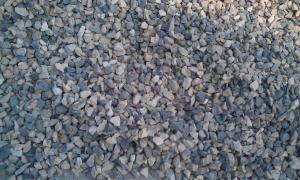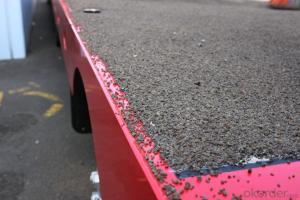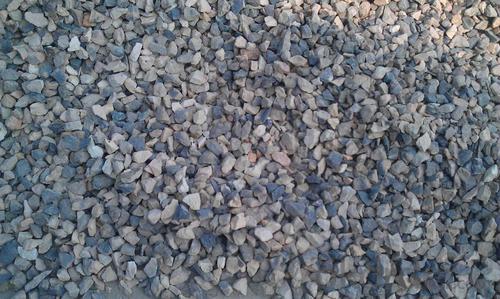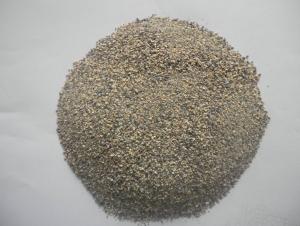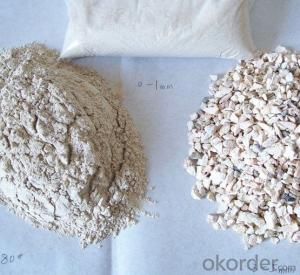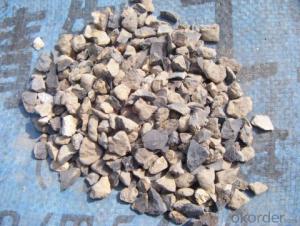Raw Materials for Refractory:Rotary / Shaft / Round Kiln Calcined Bauxite
- Loading Port:
- China main port
- Payment Terms:
- TT OR LC
- Min Order Qty:
- 25 m.t.
- Supply Capability:
- 2000 m.t./month
OKorder Service Pledge
OKorder Financial Service
You Might Also Like
Packaging & Delivery
| Packaging Details: | By wooden, loaded into containers. |
| Delivery Detail: | 60 - 120 days |
Specifications
It can work both continuously and in batch
Lowest fuel consumption
Lowest power
New Prefabricated Kiln
For quick and easy installation on flat concrete floor, very compact with latest prefab kiln technology incorporated.
The prefabricated kiln is a small or medium size kiln which is fabricated in our factory and delivered in separate modules to be joined at the site.
To reduce the investment and operation cost, we built the prefabricated kiln with suspended kiln wall, which is supported by steel structure. Thus the wheel of the kiln car will be exposed in the atmosphere, the working tempeature of wheel is designed around 80°C and the requirement for lubrication will be much less.
The Unique Waste Heat Utilization system provides less power requirement and less fuel consumption.
The main parameters of one new concept kiln with daily output of 100T to be executed in 2010 are given as below for reference only:
The designed sintering temperature: 1,670°C;
The designed limiting temperature: 1,800°C;
Output: 100T/day;
Total length: 40m (net width: 4.6m);
Product: Calcined Bauxite, Synthetic Mullite, Homogenized Materials (Synthetic Mullite, Synthetic Corundum, and so on);
Fuel: Coal gas
Fuel consumption: 30,000~33,000Nm3 of coal gas per day (its heat calorie value is about 2,700Kcal/Nm3), which is equivalent to 900Kcal per kg of calcined bauxite (Al2O3: 80~93%) at sintering working temperature between 1,650~1,670°C
Power consumption: 35~45 KWH
Firing period: 120 hours
Long firing time generating more corundum phase and few glass phase

- Q: which kind of material is chosen for fireproofing window?
- Firstly, fireproofing window glass must be tempered, ordinary glass won't play a role of fireproofing, and fireproofing window fan is fixed, can't be open, if you can open it, it won't play a role of fireproofing. And you can ask the property to provide texture report of fireproofing windows, fireproof material stipulated by our national fire protection laws and regulations must have fireproofing inspection reports, there must be. and fire window glass should have a fireproofing sign. The main role of fireproofing window is to isolate the fire, and play a role of fireproofing and escaping, avoid the fire quickly spread in.
- Q: How to divide the fire resistant level of EVB?
- According to the indicators of amount of smoke, heat value, burning rate, and ignition point, combustion performance insulation materials are divided into A (non-combustible), B1 (flame retardant), B2 (flammable), B3 (combustible). It can be divided into the organic and inorganic types: The organic includes polyurethane and polystyrene board, the inorganic the includes glass wool and rock wool. The price of organic is lower, and it is combustible materials, it will produce hydrogen cyanide and other toxic gases when burned, the inhaled would die. The inorganic material is completely non-combustible insulation material.
- Q: What are the electrical fire protection materials?
- Electrical fire protection materials are the following: 1, fire proof board It is the most commonly used materials in the market, which has the advantages of fire prevention, moisture, abrasion, oil, easiness to clean, and more varieties of colors. Installed in the building exit corridors, stairs and corridors, such as fire ceiling ceiling, it can ensure that people can be evacuated safely, and to protect people from the spread of the fire. 2, fire proof door, fire proof door is divided into wooden fire door, steel fire door and stainless steel fire door. Fire proof doors are usually used for the opening of the firewall, the entrance of the staircase, the evacuation of the aisle, the openings and other parts of the pipeline, the fire prevention, playing an important role in reducing the loss of fire. 3, fire shutter It can be set in the location where it is not convient to install a fire proof wall, fire shutter generally has functions such as good fire resistance, heat insulation, smoke, compression, anti aging, wear and corrosion. 4, fireproof and mothproof wood fire wood moth is made by putting ordinary wood into the solution containing calcium and aluminum, and then into the solution containing phosphate and silicate. In this way, two ion will be undergong chemical reaction in the wood, forming materials similar to the ceramic, and filling the gap of cells and tissues, so that allowing it to have fireproof and mothproof performance.
- Q: How is the grading of the level A new material fire insulation material?
- The thermal insulation materials are generally divided into level A and level B according to the flame rating. Level A is the non-combustible material, and level B is the combustible materials. The level B material is to blame for the fire in Shenyang hotel in CCTV building a few years ago . At present, the level A materials are widely used, with some prices even cheaper than the level B material. A level is roughly divided into insulation mortar, phenolic board, rock wool board and foam cement board, ect.
- Q: Who can introduce the difference between galvanized fireproof?coatings and steel structure fireproof materials?
- When the steel surface derusted, it generally needs to brush rich-zinc primer before spraying fireproof coating. Fireproof coating plan itself includes anticorrosion plan, and fireproof coating is just a layer of coating plans, which is an intermediate layer in general. Fireproof coating plan generally includes primer, fireproof coating and finishing paint. Some fireproof coatings can be directly painted on the bare steel elements without primer and finishing paint. Galvanized surface generally is not necessarily needed for brushing fireproof coating. Fireproof and galvanized surface have relatively poor bond strength, so it is advisable to brush transitional lacquer or micaceous iron on the galvanized surface.
- Q: Is the ball mill used in production of refractories?
- Refractory is a kind of non-metallic material that is of resistance to thermal shock and chemical erosion, low thermal conductivity and low expansion coefficient. The refractoriness of the refractory is not less than 1580℃. The usage of the refractory is broad. Refractory materials include refractory bricks and powders. Abandoned refractory bricks can be recreated as new bricks after they are crushed by a crusher and grinded by a ball mill. The ball mill and crusher are needed to grind and crush the material in the production of the refractory. The ball mill produced by Zhengzhou Xinhai Machinery Manufacturing Co. has excellent performance and there are many successful cases in Inner Mongolia, Heilongjiang and Guangdong. At the request of the national environmental policy, the company adjusts the equipment details, allowing the equipment to ensure the volume of production while reduce energy consumption.
- Q: The performance of refractory material
- The mechanical properties of refractory material include withstand voltage strength. The structure properties of the refractory materials include porosity, bulk density, such as thermal emission rate. The physical properties of the refractory materials include temperature conductivity structure performance, wear resistance, hiphotos, electrical conductivity, creep, the hydration resistance, adhesive strength.
- Q: Fire insulation and fireproof insulation board materials What is the difference in performance?
- Fireproof Materials prevents burning through insulating while others by chemical reactions. The overall heat conductivity coefficient of Insulation materials are generally lowered by thermal conductivity of the material itself and the structure of it. Inorganic active insulation material uses ordinary cement, insulation stone, calcium powder, Platycodon grandiflorum as the main raw material.
- Q: What's the A class fireproof and thermal inuslation matertial for external wall?
- It is roughly divided into thermal insulation mortar, phenolic foam board, rock wool board, foamed cement board, etc. Insulation mortar is quite good for its simple construction, convenience and low cost, but its production is too simple to make fake products easily. If you want to use the material, it is suggested to find a large plant with complete procedures such as provincal records of production and use, city records, test report above provincial levels, national fire inspection report, design drawings sheets of Department of Construction, etc. If there is lack of any one, it is unsafe. Hope my answer is helpful for you.
- Q: What is fire retardant coating mainly used for?
- The functions of refractory coating are as follows: 1. Non-intumescent fire retardant coating is mainly used for the fireproofing of wood, fiber board and other materials, and it is used in the surfaces of wood truss, roof, doors, windows and etc. Second, the intumescent fire retardant coating can be divided into non-toxic intumescent fire retardant coating, expansible fire retardant coating emulsions, solvent-based fire retardant coating. 3. Non-toxic intumescent fire retardant coating can be used to protect cables, polyethylene pipes and insulation board. 4, The expansible fire retardant coating emulsion and solvent-based fire retardant coating can be used for fireproofing of buildings, electricity power, and cables. 5. New fire retardant coating: Transparent fire retardant coating, water-soluble intumescent fire retardant coating, fireproof emulsion paint, polyvinyl acetate emulsion fire retardant paint, water-soluble intumescent fire retardant paint drying at room temperature, fire insulation coating polyolefin fire retardant coating, modified high chloropolyethylene fire retardant paint, chlorinated rubber fire retardant coating, firewall coating, intumescent coatings, wire and cable fire retardant paint, new fire retardant coating, casting fire retardant coating and so on.
Send your message to us
Raw Materials for Refractory:Rotary / Shaft / Round Kiln Calcined Bauxite
- Loading Port:
- China main port
- Payment Terms:
- TT OR LC
- Min Order Qty:
- 25 m.t.
- Supply Capability:
- 2000 m.t./month
OKorder Service Pledge
OKorder Financial Service
Similar products
Hot products
Hot Searches
Related keywords
